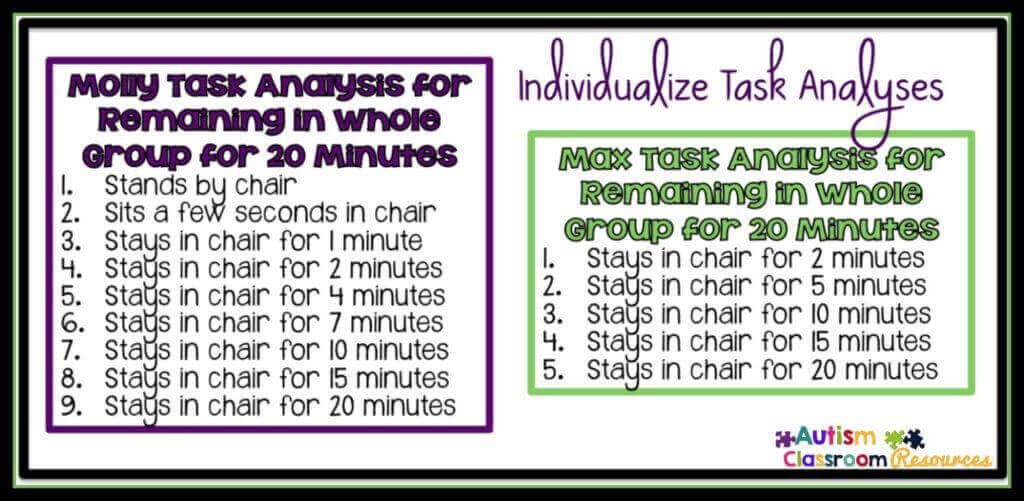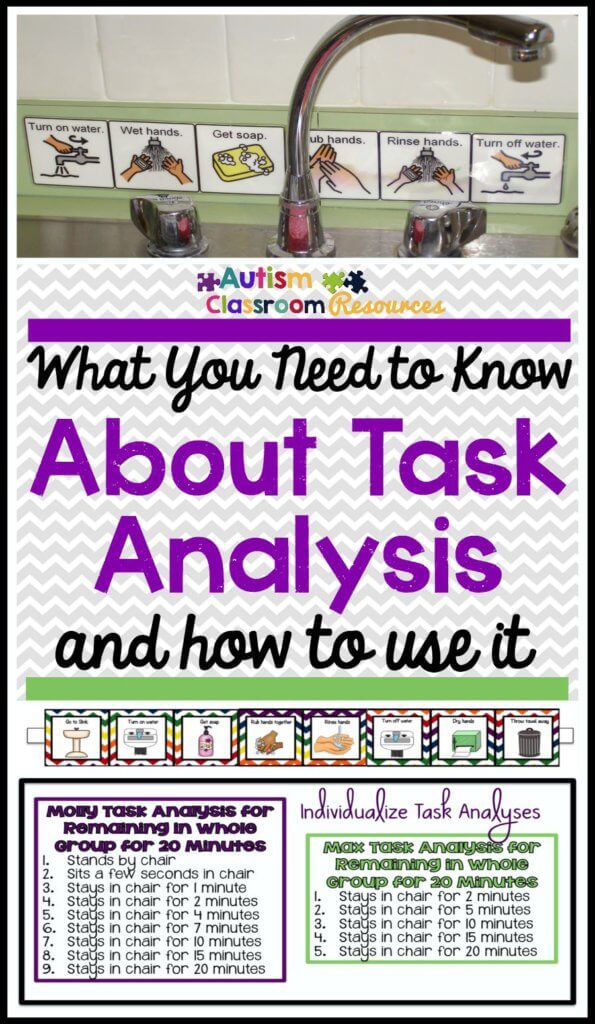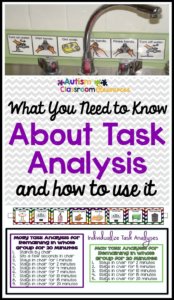Sharing is caring!
Returning to the Effective Interventions in Applied Behavior Analysis series, I wanted to talk a little about the use of task analysis and why it’s important. For more information on how we use task analyses, check out this post on using shaping and this one on using chaining.
Everyone in special education has probably heard about task analysis. It’s a decidedly unexciting topic in some ways, but it so critical to systematic instruction that we have to address it. In addition, there is a lot of misinformation flying around out there so hopefully this will address just what you need to know about them.
We are told to use them frequently in the classroom to break skills down into smaller components. So, we set up steps, like we do for some of our mini-schedules like the one below for washing hands. Sometimes task analyses have visuals to support them and sometimes they are just written out for the staff.
What is a task analysis?
So if you aren’t familiar with the jargon, what does task analysis mean? The National Professional Development Center found task analysis to be an evidence-based practice, which interests me because I don’t think that behavioral task analysis is actually an intervention. I see the task analysis process as part of other interventions. A task analysis is simply a set of steps that need to be completed to reach a specific goals. There are basically two different ways to break down a skill. You can break it down by the steps in a sequence to complete the task. The hand washing task analysis does that. In this type of task analysis you have to complete one step to be ready for the next. For instance, you have to turn on the water to get your hands wet. This type of task analysis is typically used with chaining which will be the topic of our next post.
You can also have a task analysis that breaks skills down into smaller chunks, like increasing time. A task analysis for remaining in a group might do that like the examples at the bottom of the picture above. In this type of task analysis, each step replaces the one that comes before it. So, when you sit for 5 minutes, that includes all the steps that come before. This type of task analysis is usually used with shaping, which I will talk about in 2 weeks.
Why Do I Need a Task Analysis?
So if a task analysis is just breaking skills down into smaller skills, you probably do it all the time. Conducting a task analysis isn’t a very time-consuming process.
But, why is using a specific task analysis that is established for a student important? Below are 3 reasons to answer that question.
1. Consistency

In order to assure that everyone is teaching a skill in the same way, breaking it down into the same steps is critical. I am willing to bet that if you ask parents, paraprofessionals or even your significant other how they brush their teeth, you will find some variation in the order of the steps. Your significant other doesn’t put the cap back on the toothpaste. You keep the water running while you brush your teeth while your paraprofessional turns it off to conserve water until she is ready to rinse. My point is that we all have individual differences in the steps of completing simple, everyday tasks. Now, imagine that you are a student who is having difficulty learning to brush his teeth. If you show me one way and prompt me through the steps, and then the parapro shows me another way and prompts me through her steps, and my mom shows me a third way, I’m going to be pretty confused. It’s the beginning of the year and we all need a laugh, so here’s a great video example of why it’s important. Archie and Michael can’t even agree on how to put on shoes and socks. Imagine if they both tried to teach one of our students to put theirs on (no, I would not recommend doing this)–how confused would that student be?
Take Away Point: Writing down a task analysis assures that everyone follows the same steps and teaches the student the same way. Then your instruction is much less confusing and more efficient.
2. Tailor It To The Student

Students need task analyses that are tailored to their needs. I love starting with standard ones, so I don’t have to reinvent the wheel, but then adjusting them to meet the needs of this student. Here’s why the individualization is so important. If your steps are too large for the student, he or she may not make it to the next step and will stall out. For instance, if you are teaching Molly to stay in a group activity for 20 minutes and your task analysis jumps from 5 minutes (that she can currently stay) to 10 minutes, she might never be successful at jumping to 10 minutes and won’t progress. She might do better if we went to 7 minutes next and then 9 minutes. On the other hand, for Max, if we were teaching the same skill and we had him stay in the group for 5 minutes, then 7 minutes and then 9 minutes it might take a very long time when he could have made the jump straight to 10 minutes. Each student is different and we have to figure out how to individualize their steps based on their past data. Is it taking too long to master a step? Step it down to a smaller step. Is he mastering steps really quickly? Make the steps bigger.
3. It is the Basis for Systematic Instruction
Breaking skills down is a critical component of discrete trial programming as well as teaching life skills and other chaining and shaping applications. Discrete trial programs are made up of smaller steps that lead to a larger goal. Learn 1 letter, then 2, then 3? That’s a shaping task analysis. Our research shows us that it’s important to break skills down for students with autism in order to eliminate extraneous variables that might mess up their learning. Teaching systematically is the key to success with any student and especially any student in special education. It’s also key for some of our students to be able to show progress. While it’s not exciting to say that a student has mastered 4 of the 8 steps of tying his shoes, it better than being able to say AGAIN that he can’t tie his shoes–assuming he had no steps mastered earlier in the year. It’s slow progress, but it’s progress.
So, how do you use task analyses in your classroom and why do you think they are important? Are there questions you have about task analyses or teaching strategies that use them? Please share them in the comments and I will try to address them. In the meantime, I’ll be back next Thursday to talk about ways to make your instruction using task analyses more efficient.




![Summer resources to help survive the end of the year in special education [picture-interactive books with summer themes]](https://autismclassroomresources.com/wp-content/uploads/2018/05/SUMMER-RESOURCES-ROUNDUP-FEATURE-8528-768x768.jpg)




